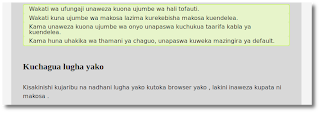This is a post about what exactly KwaMoja is, and why we are doing it, and also to explain properly what it is not.
When it became obvious that certain people were intent on destroying the project for their own selfish ends, I got involved more deeply.
Many people and companies in the west have become wealthy by being consultants in the implementation of ERP systems. They have no financial interest in the software themselves. They merely work on the implementation side, and people like SAP get the software fees themselves. These fees are often prohibitive to African companies. Our aim at KwaMoja is to build an ecosystem so that many people can get rich on the back of the KwaMoja project. Our aim is to get as many people as possible selling consultancy services around this project.
Consultants who work for $250 a day are considered very cheap, even in African countries. The rewards can be huge.
Origins
KwaMoja has its origins in some lectures I did at a community college in Kenya. The basis of the lectures was extending the webERP software in various directions. After the lectures some of the students wanted to carry on the work. Due to the unfriendly and often abusive style of management at webERP and I suggested they speak to Munir Patel who had previously talked to me about doing an African/Indian based fork of webERP, and so KwaMoja was born.When it became obvious that certain people were intent on destroying the project for their own selfish ends, I got involved more deeply.
Vision
Our vision at KwaMoja is to make African businesses more competitive with those in the west. In the Eighties, western businesses went through a revolution, lowering inventory costs, improving efficiencies, improving quality, and raising profits for their shareholders. Central to this revolution was the rolling out of ERP software. Very few businesses in the west do not now take advantage of ERP. We believe that KwaMoja is that ERP software for African businesses.Free Software
KwaMoja is Free software. Now free in this sense means that KwaMoja code comes to you free of restrictions. You can do whatever you like with it, so long as you maintain those freedoms. When you buy software from Apple for instance, the software comes with many restrictions as to what you can and cannot do with it. You can only use it to do what some people in grey suits at Apple's HQ want you to do with it. Free software does not necessarily mean that you cannot charge people for the software, anybody who wants to charge for KwaMoja can do, and anybody who wishes to give it away free can also do that.Where is the money?
KwaMoja itself has no funding. It is not a company, we have no income, and we have no employees. It is made possible by donations of time and money from those of us involved. However we are not super rich philanthropists. Far from it, and we have had to earn money elsewhere while getting the project ready for release. There is no money to pay web designers, programmers etc.Many people and companies in the west have become wealthy by being consultants in the implementation of ERP systems. They have no financial interest in the software themselves. They merely work on the implementation side, and people like SAP get the software fees themselves. These fees are often prohibitive to African companies. Our aim at KwaMoja is to build an ecosystem so that many people can get rich on the back of the KwaMoja project. Our aim is to get as many people as possible selling consultancy services around this project.
Consultants who work for $250 a day are considered very cheap, even in African countries. The rewards can be huge.
Why would someone need consultancy?
According to research at least 65% of ERP implementations fail. Failure can often have disastrous implications for a business, whilst success can bring huge benefits to a business. Employing good experienced consultants is often the difference between success and failure. This is why western businesses will always pay for consultancy.Why would I want to donate my time and skills?
Good question. As I have said above we are none of us rich philanthropists, and we are all seeking to make some money in the end. Imagine you are a company that is looking for consultancy support for it's implementation . Would you choose a consultant who has been actively involved in the building of the software, or someone who has done nothing for it? My guess is that those who contribute the most will earn the most as consultants. You would also gain a global audience to showcase your skills.
Is it just for Africa?
No, definitely not. This software can be used anywhere in the world.
Conclusion
So there it is, that is what KwaMoja is. Sound interesting? Then join us, there is always tons to do.














